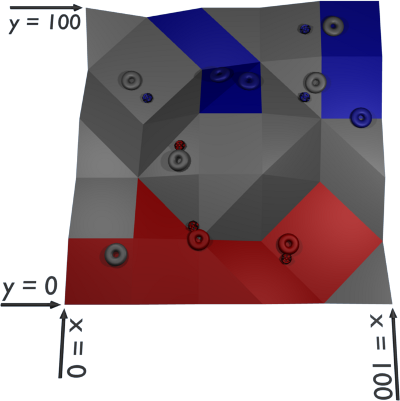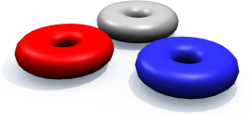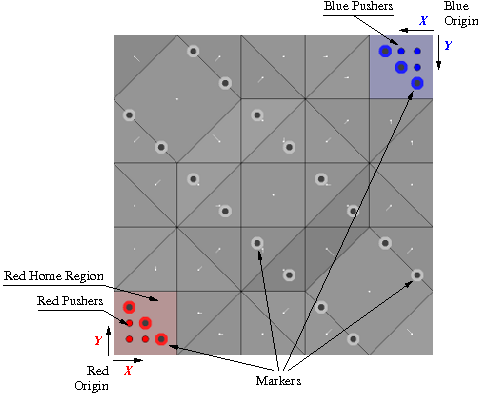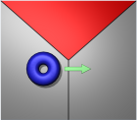 |
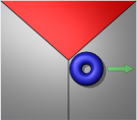 |
|
Likewise, if a blue region has just one marker touching it and that marker is grey, then grey is applying pressure to the region. If that marker leaves the region, but another grey marker touches the region before the end of the turn, then grey continues to apply pressure to the region.
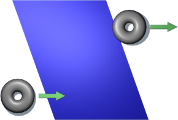 |
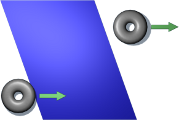 |
|
Color coercion takes place simultaneously for all affected regions and markers. It's possible for a region and a marker inside it to be coerced to each other's colors at the same time. For example, if a red marker is inside a grey region that's also touched by a blue marker, then grey is applying pressure to the red marker, but red is not applying pressure to the region. If the blue marker is pushed out of the region after 20 turns, red will begin applying pressure to the region while the grey region continues to apply pressure to the marker. Another 20 turns later, the marker may be coerced to grey while the region is coerced to red.
 |
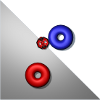 |
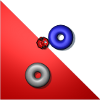 |
||
Gravity
At the start of each turn, before players receive descriptions of the game state, pusher and marker velocities are updated based on gravitational acceleration and the slope of the region under them. The location of the center of a pusher or a marker determines what region it's affected by. If the center of a game piece is inside a region that slopes, its velocity will be affected by the slope. If the center of a piece is directly on the boundary between two or more regions, its velocity is not affected by any region (since locations are represented as real numbers, this condition is unlikely after the start of the game).
The effects of gravity are computed by considering the three-dimensional geometry of the field. However, only its influence in the X and Y directions is used. The game does not consider any Z component of velocity for moving pieces.
Gravity is based on a one unit per turn per turn acceleration in the negative Z direction. Acceleration due to gravity is computed by projecting a unit vector in the negative Z direction, g, into a component perpendicular to the region surface and a component, p, parallel to the region surface. The component perpendicular to the surface is ignored. The X and Y components of p are added to the velocity of the affected marker or pusher at the start of each turn.
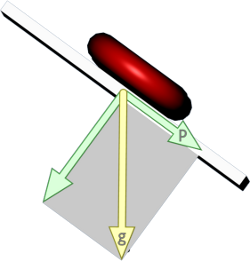
The default game visualization indicates how field regions are sloped by shading the regions appropriately and drawing a little white line at the middle of the region. The line represents a vector perpendicular to the surface of the region. The thin end points the way playing pieces will slide while they are on the region. The length of the line indicates how steep the slope is.
Friction
Only the markers are subject to friction. At the start of each turn, after the influence of gravity has been considered, friction is applied. The speed of each marker is reduced by 0.35 units per turn (or set to zero if speed is less than 0.35). Since friction is applied after gravity, but before the turn is simulated, small amounts of gravitational acceleration may have no effect on a stationary marker. However a stationary marker will start to slide downhill if the slope is sufficiently steep. Pushers, which do not experience friction, will always tend to slide downhill.
Simulated Time and Collisions
During the simulation of a turn, moving objects may collide with each other or with the edges of the field. Collisions are handled elastically and occur on a continuous timescale. Although players only see instantaneous snapshots of the game state at the beginnings of the turns, events like collisions may occur at intermediate times between these snapshots. For example, pretend a pusher has a position three units from the edge of the field and is moving straight toward the edge with a speed of six. That pusher will bounce off the edge one third of the way through the simulation of the turn (pushers have a radius of 1). Its velocity will be reversed and its position will be five units from that edge the next time the player gets to make a move, provided nothing else interferes with it.
Score and Winning
A player's score is the size of the player's territory, the total area of all regions that match the player's color. This area calculation considers the size of each region in the X and Y dimensions, ignoring changes in Z and effectively projecting regions into the XY plane before computing their area. Regions on the map will always have integer areas.
At the end of the game, the player with the largest territory is the winner. If there is a tie in the territory size, then players' territory sizes at the end of each turn are summed across all game turns. The player with the larger sum is considered the winner.
